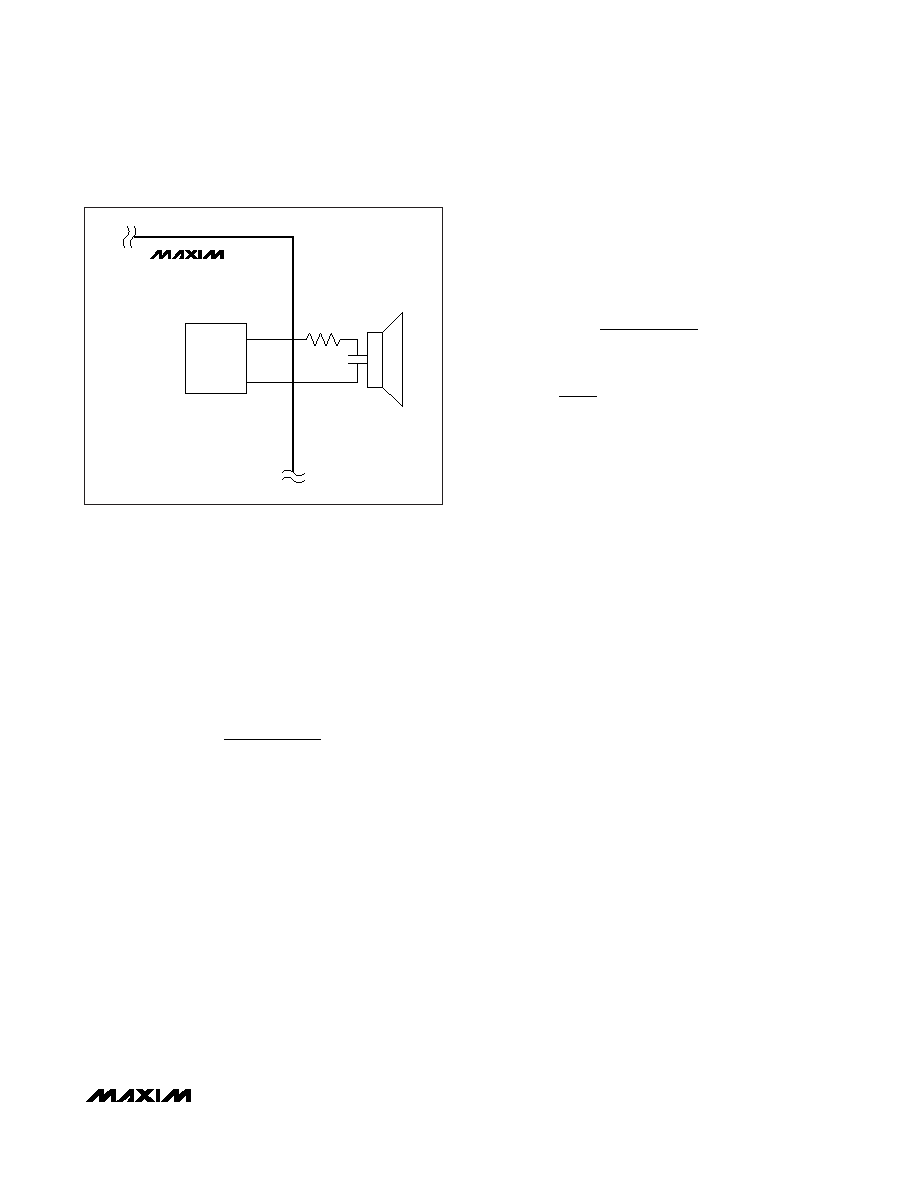- 您現(xiàn)在的位置:買賣IC網(wǎng) > PDF目錄16786 > MAX9738EVKIT+ (Maxim Integrated Products)KIT EVALUATION FOR MAX9738 PDF資料下載
參數(shù)資料
| 型號(hào): | MAX9738EVKIT+ |
| 廠商: | Maxim Integrated Products |
| 文件頁(yè)數(shù): | 3/14頁(yè) |
| 文件大小: | 0K |
| 描述: | KIT EVALUATION FOR MAX9738 |
| 產(chǎn)品培訓(xùn)模塊: | Lead (SnPb) Finish for COTS Obsolescence Mitigation Program |
| 標(biāo)準(zhǔn)包裝: | 1 |
| 放大器類型: | G 類 |
| 輸出類型: | 1-通道(單聲道) |
| 電源電壓: | 2.7 V ~ 5.5 V |
| 工作溫度: | -45°C ~ 85°C |
| 板類型: | 完全填充 |
| 已用 IC / 零件: | MAX9738 |
| 已供物品: | 板 |
| 相關(guān)產(chǎn)品: | MAX9738EWP+TG45-ND - IC AMP AUDIO PWR MONO G 20WLP |
第1頁(yè)第2頁(yè)當(dāng)前第3頁(yè)第4頁(yè)第5頁(yè)第6頁(yè)第7頁(yè)第8頁(yè)第9頁(yè)第10頁(yè)第11頁(yè)第12頁(yè)第13頁(yè)第14頁(yè)

Component Selection
Input Coupling Capacitors (CIN_)
The AC-coupling capacitors (CIN_) and input resistors
(RIN_) form highpass filters that remove any DC bias from
an input signal (see the
Typical Application Circuit/
Functional Diagram). CIN_ blocks the input signal source
from appearing at the amplifier outputs. The -3dB point of
the highpass filter, assuming zero source impedance due
to the input signal source, is given by:
Ceramic speakers generally perform best at frequen-
cies greater than 1kHz. To reduce low-frequency dis-
tortion that may be added by the ceramic speakers
low-frequency response, select a CIN such that the
f-3dB closely matches the low-frequency response of
the ceramic speaker. Use capacitors with low-voltage
coefficient dielectrics. Aluminum electrolytic, tantalum,
or film dielectric capacitors are good choices for AC-
coupling capacitors. Capacitors with high-voltage coef-
ficients, such as ceramics (non-C0G dielectrics), can
result in increased distortion at low frequencies.
Boost Converter Output Capacitor Selection (C1)
The total output voltage ripple has two components: the
capacitive ripple caused by the charging and
discharging of the output capacitance, and the voltage
drop across the capacitor’s ESR caused by the current
into and out of the capacitor. The worst-case voltage
ripple is:
where IL_RIPPLE is the inductor ripple current. For
ceramic capacitors, the output voltage ripple is typically
dominated by VVSS_RIPPLE(C). The voltage rating and
temperature characteristics of the output capacitor must
also be considered. Note that all ceramic capacitors
typically have large temperature coefficients and bias
voltage coefficients. The actual capacitor value in the
circuit is typically significantly less than the stated value.
Input Filter Capacitor (C2)
The input capacitor reduces the current peaks drawn
from the input supply and reduces noise injection into
the IC. A 10μF ceramic capacitor is recommended for
the
Typical Applications Circuit/Functional Diagram
because of the high-source impedance seen in typical
lab setups. Actual applications usually have much
lower source impedance since the step-up regulator
often runs directly from a battery. Typically, the input
capacitance can be reduced below 10μF.
Boost Flying Capacitor (C3)
A bootstrap circuit that uses an external flying capaci-
tor between LX and BST provides the supply voltage
for the internal n-channel MOSFET driver. A 0.1μF or
larger ceramic capacitor provides sufficient current for
the internal MOSFET driver supply.
Inductor Selection
The MAX9738 operates with a standard 2.2μH inductor
for the entire range of supply voltages and load cur-
rents. The inductor must have a saturation (incremen-
tal) current (ISAT) rating greater than the peak switching
current. Choose an inductor that has a higher ISAT rat-
ing than the given FET Current Limit (Transient) specifi-
cation in the
Electrical Characteristics table.
Temperature characteristics of the inductor’s saturation
current must also be considered.
VV
V
I
2C
V
VI
R
I
V
1
VSS_RIPPLE
VSS_RIPPLE(C)
VSS_RIPPLE(ESR)
VSS_RIPPLE(C)
L_RIPPLE2
SS
VSS_RIPPLE(ESR)
L_RIPPLE(ESR)
ESR
L_RIPPLE
BAT
=+
=
×
××
×
=×
L
t
and
where
L
t
FON
1
f dB
Hz
=
××
()
3
1
2R
C
IN
π
MAX9738
16VP-P Class G Amplifier with
Inverting Boost Converter
______________________________________________________________________________________
11
MAX9738
OUT+
RL
OUT-
CLASS G
OUTPUT
STAGE
Figure 3. Driving a Ceramic Speaker
相關(guān)PDF資料 |
PDF描述 |
|---|---|
| 1641-181K | COIL .18UH MOLDED SHIELDED |
| MC1403BD | IC VREF SERIES PREC 2.5V 8-SOICN |
| EEC26DRYN-S734 | CONN EDGECARD 52POS DIP .100 SLD |
| GCC18DRYI | CONN EDGECARD 36POS DIP .100 SLD |
| V300B12E150BG3 | CONVERTER MOD DC/DC 12V 150W |
相關(guān)代理商/技術(shù)參數(shù) |
參數(shù)描述 |
|---|---|
| MAX9738EVKIT+ | 功能描述:放大器 IC 開(kāi)發(fā)工具 MAX9738 Eval Kit RoHS:否 制造商:International Rectifier 產(chǎn)品:Demonstration Boards 類型:Power Amplifiers 工具用于評(píng)估:IR4302 工作電源電壓:13 V to 23 V |
| MAX9738EWP+T | 制造商:Maxim Integrated Products 功能描述:16VP-P CLASS G AMPLIFIER WITH INVER - Tape and Reel |
| MAX9738EWP+TG45 | 功能描述:音頻放大器 16VP-P Class G Amplifier RoHS:否 制造商:STMicroelectronics 產(chǎn)品:General Purpose Audio Amplifiers 輸出類型:Digital 輸出功率: THD + 噪聲: 工作電源電壓:3.3 V 電源電流: 最大功率耗散: 最大工作溫度: 安裝風(fēng)格:SMD/SMT 封裝 / 箱體:TQFP-64 封裝:Reel |
| MAX973C/D | 功能描述:校驗(yàn)器 IC RoHS:否 制造商:STMicroelectronics 產(chǎn)品: 比較器類型: 通道數(shù)量: 輸出類型:Push-Pull 電源電壓-最大:5.5 V 電源電壓-最小:1.1 V 補(bǔ)償電壓(最大值):6 mV 電源電流(最大值):1350 nA 響應(yīng)時(shí)間: 最大工作溫度:+ 125 C 安裝風(fēng)格:SMD/SMT 封裝 / 箱體:SC-70-5 封裝:Reel |
| MAX973CPA | 功能描述:校驗(yàn)器 IC RoHS:否 制造商:STMicroelectronics 產(chǎn)品: 比較器類型: 通道數(shù)量: 輸出類型:Push-Pull 電源電壓-最大:5.5 V 電源電壓-最小:1.1 V 補(bǔ)償電壓(最大值):6 mV 電源電流(最大值):1350 nA 響應(yīng)時(shí)間: 最大工作溫度:+ 125 C 安裝風(fēng)格:SMD/SMT 封裝 / 箱體:SC-70-5 封裝:Reel |
發(fā)布緊急采購(gòu),3分鐘左右您將得到回復(fù)。